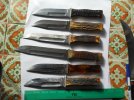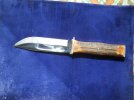- Joined
- May 3, 2015
- Messages
- 40
I recently inherited an old Ka-Bar from my grandfather and I'm trying to find more info. It has 6G4-5 stamped on the guard. I'm guessing the 5 is for 5" blade but the rest?? I took it to a Knife show a few weeks ago and one of the vendors (an avid kabar collector) got really excited about it and offered me $200+ a Spyderco Delica for it... but it's not for sale. A couple things I noticed... there is no patent or patent pending marks below the Ka-Bar stamp... Research shows that it was patented in 1926, and Ka-bar first appeared in '23... does this mean my knife is between '23 and '26? Also there is a very similar knife on ebay http://www.ebay.com/itm/Vintage-Ka-...946?pt=LH_DefaultDomain_0&hash=item463a638b32 and it says Reg US Pat off under KA-BAR. It also has 5 pins while mine has 4. There seems to be very little info to distinguish KA-BARs made between '23 and the war. Any ideas? not sure how to add pics but it looks just like the one in the Ebay listing.













